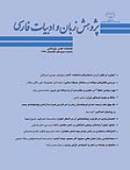بررسي تقابلهاي دوگانه در ساختار حديقه سنايي
محورهای موضوعی : پژوهشهای ادبیات کلاسیک ایرانمحمد امير عبيدينيا 1 , علي دلائي ميلان 2
1 -
2 -
کلید واژه: سنايي حديقه الحقيقه تقابلهاي دوگانه ساختارگرايي پساساختارگرايي حکايت شخصيت روساخت ژرف ساخت,
چکیده مقاله :
تقابلهاي دوگانه، يکي از مفاهيم اساسي در نقد ساختارگرايي، پساساختارگرايي و نظريات زبانشناسي و نشانهشناسي است که در باورهاي اساطيري و فرهنگي بشر ريشه دارد. در جاي جاي حديقه سنايي، ميتوان رد پاي تقابلهاي دوگانه را يافت. در سطح روساختي حديقه، تركيب واژگان، عنوان سر فصلها، تناسب ابيات و چينش مطالب، تقابل دوگانه دارند و در سطح ژرف ساختي اين كتاب هم، ميان مضامين متوالي بيان شده، چنين تقابلي وجود دارد. در سطح روساختي حكايتها، ميان شخصيتها، تقابلدوگانه حاكم است و ژرف ساخت حكايتها هم حول همين محور ميچرخد. در اين مقاله ابتدا مفهوم اصطلاحي تقابلهاي دوگانه در نظريات مختلف مورد بررسي و تحليل قرار گرفته، آنگاه ريشه تقابلهاي دوگانه در سطح روساختي و ژرفساختي، بخصوص در شخصيتپردازي حکايتهاي حديقه، مشخص و طبقه بندي شده است.
'Binary oppositions' is considered as one of the basic concepts of structural and post-structural critique, and theories of linguistics and semiotics. It is rooted in mythological and cultural beliefs of the humans. Binary oppositions can be found throughout Hadiqa. At the level of its surface structure, the phrases, headings, the relations between lines and their arrangements show binary oppositions. At its deep structure, there can be found such oppositions among the successively expressed contents. At the surface structure of its narratives, the characters are of binary oppositions. Their deep structure also centers on this concept. The present article first studies and analyzes the term 'binary oppositions' concerning with different theories, and then classifies the origins of the binary oppositions in both the surface and deep structures of Hadiqa, especially considering its characterization.


